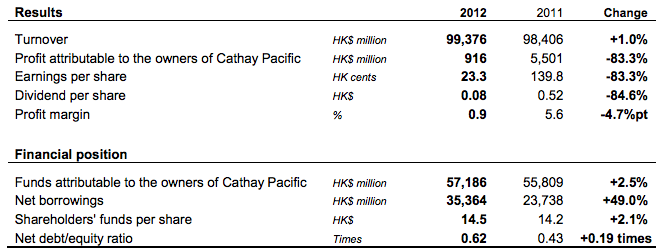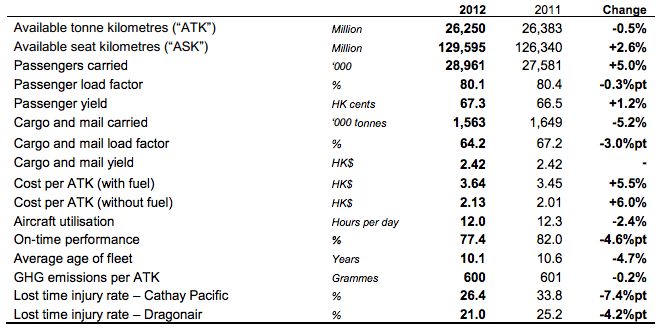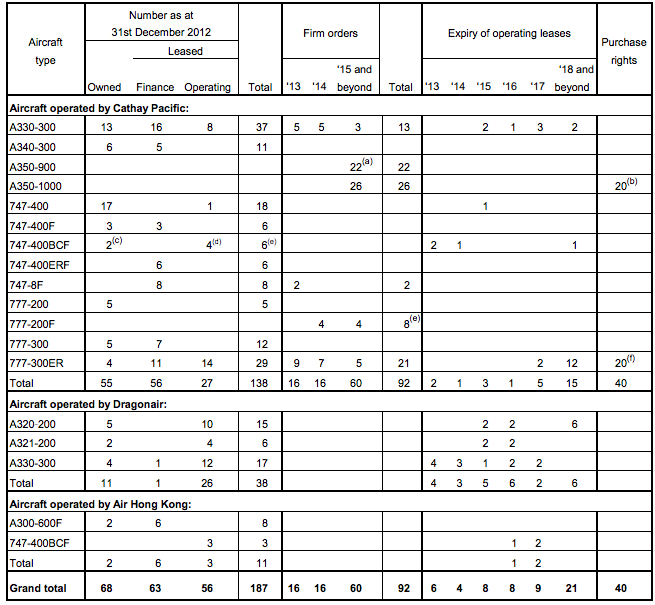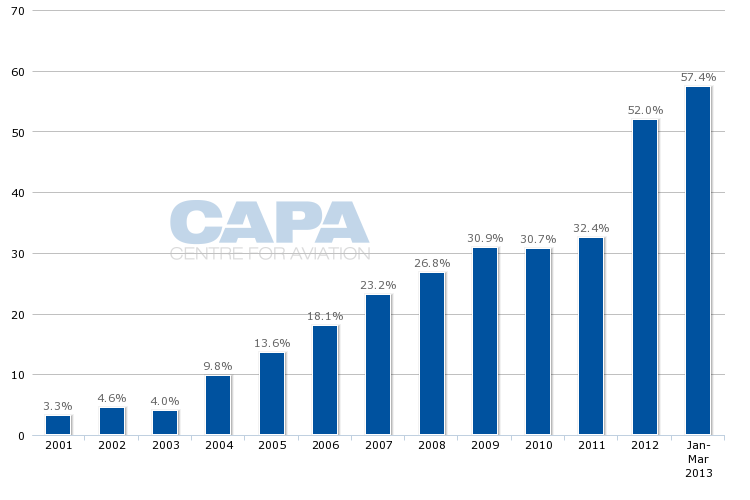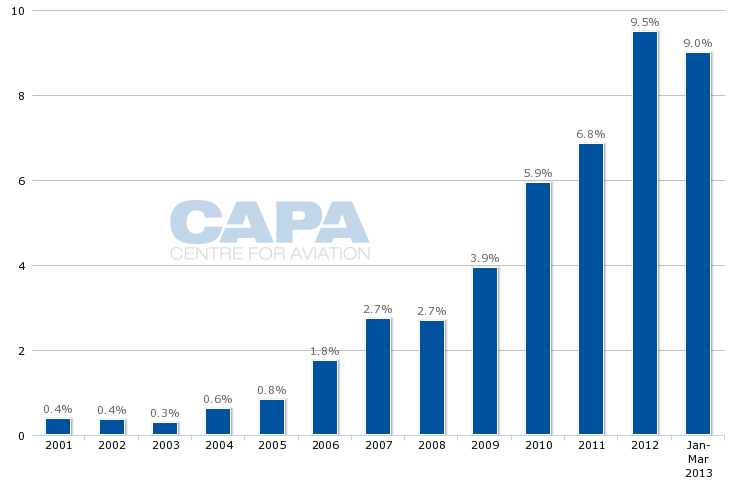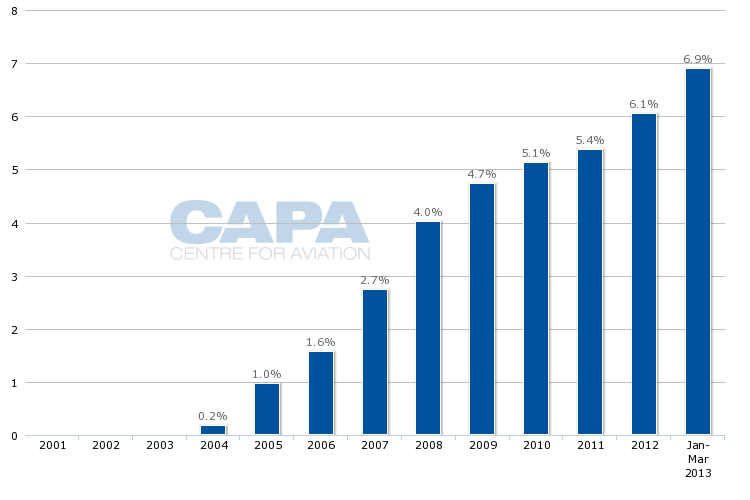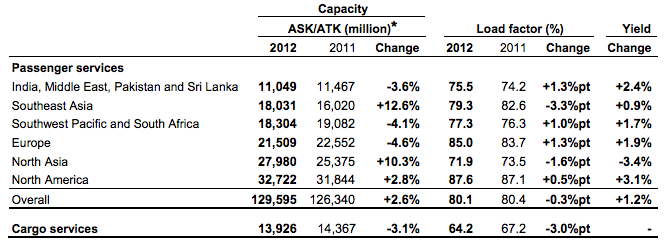Cathay Pacific, posting 84% drop in profits, seeks consistency but offers no brave new strategies
Cathay Pacific has lost its ability to move faster than the changing North Asian market, and this is reflected in an 84% drop in 2012 profits to HKD916 million (USD118 million). Although this is a profit, unlike global peers, it was achieved with a paltry 1.8% operating margin.
Cathay's solution is to offer consistency in what it has done, rather than focus on what it can do differently. When the market rebounds, it will do so with a new competitive landscape that gives no guarantee past traffic can be regained. Even Cathay management seems unconvinced by its own explanation for why it does not have a low-cost carrier subsidiary. But LCCs are just part of the changing environment: Cathay needs strategic partners and a wider long-haul network, neither of which show signs of eventuating in the short-term.
Cathay is a cautious and conservative airline; it has relied on delivering benchmark quality to distinguish it. While this has advantages, the quickening pace of North Asian aviation will demand that Cathay break out of its shell. At the least, this will let Cathay counter competition while a more enduring effort will let it overtake the competition.
Cathay turns around first half loss to post full-year profit, but airlines loss-making
Cathay on 13-Mar-2013 announced its profit for the year to 31-Dec-2012, reversing a rare first half loss. The second half, coinciding with the northern summer season and mainland Chinese holidays, is traditionally stronger.
See related article: Cathay Pacific may rebound from rare half-annual loss but its glory days are fading
But this profit is for the Cathay Pacific Group. The two airlines - Cathay and Dragonair - had a pre-tax profit of HKD158 million (USD20.4 million) on combined passenger and cargo revenue of HKD94.688 billion (USD12.197 billion), a margin there of 0.1%, barely squeaking into an operational profit. After tax, the airlines had a HKD110 million loss (USD14 million). Profit from subsidiaries and associates (notably Air China) brought the group back to profit. Cathay is not yet seizing on its loss-making carriers to push for radical change, as other carriers in various regions have.
Cathay throughout the year suffered, as expected, from the usual suspects of high fuel prices, but it also hurt on the other side of the ledger: weakened demand in the key Europe market and soft demand in premium cabins as well as increased competition in economy class, affected yields.
Cargo, critical for a carrier on the doorstep of China, suffered reduced loads and yields. Cathay's new cargo terminal at Hong Kong is to become fully functional in 2013 and promises faster handling times and better capability over peers to handle climate-sensitive cargo.
At Cathay and peers in mainland China, the second half was projected to be stronger than actually eventuated, a result of slowing infrastructure and the once-a-decade leadership transition in mainland China that brought many businesses, and associated travel, to a near halt.
Cathay for the full year 2012 benefitted from improved results at Air China, of which it owns 19.57% as part of a cross-equity arrangement, that Air China was able to contribute to Cathay's first half results. But Air China's performance overall remains down.
Cathay Pacific Group financial statistics: 2011-2012
Fleet efficiency opportunities are running out; new cost cutting is needed
Capacity measured in ASKs in 2012 was up 2.6% on the back of growth at Dragonair and contraction at Cathay mainline, the first contraction at the flagship brand in a number of years. Subtle pressures appeared across the operation: passenger load factor decreased 0.3%; cargo and mail load factor decreased 3.0%; and aircraft utilisation was down 2.4%. The growth and contraction vary widely by region, with Asia seeing strong double-digit growth, notable growth in North America and decreases in Europe.
Cathay over 2012 accelerated the replacement of 747-400s with 777-300ERs. Besides the 777 being more fuel-efficient than the 747, a number of Cathay's 747s were approaching costly heavy maintenance checks. The replacement of 747s with 777s resulted in a decline in capacity due to the 777's smaller size, but would have positively impacted the bottom line. In 2013 Cathay will take nine more 777-300ERs, increasing its 777-300ER fleet by nearly a third. Fuel on short-haul sectors can account for 35% of costs while for ultra-long-haul flying fuel is upwards of 60% of costs.
As at 31-Dec-2012, Cathay plans to remove six passenger 747-400s over 2013, leaving 12 of the type at the end of the year. (Cathay is hopeful it will be able to remove a seventh passenger 747 in 2013.) In 2012 Cathay removed three passenger 747-400s.
Besides the 11 A340s that are deployed primarily on non-competitive routes (Auckland, Middle East and South Africa), Cathay's fleet is relatively efficient, meaning further cost cutting - necessary, of course, in air transport, as every one of its competitors is doing so - will be more challenging.
After fleet replacements, Cathay's proposed cost savings are a hiring freeze, non-essential business travel and reduced marketing and IT spending; these are relatively minor.
Cathay Pacific Group operation statistics: 2011-2012
Cathay prides itself on being a high-frequency carrier, but its North Asia load factor in 2012 was 71%, below the overall average of 80.4%. Regional competition is increasing, and competitors adding capacity - such as Hong Kong Airlines, Spring and forthcoming Jetstar Hong Kong - have lower cost bases. Dragonair in Jan-2013 announced a long overdue cabin upgrade that will better position it as a full-service option in the region, but these upgrades will add cost plus incremental costs will be incurred due to the product's increased weight and licensing fees, such as for IFE. The global lesson is that short-haul premium cannot stack up against lower-cost competitors.
While Cathay and Dragonair rely extensively on connecting traffic, this is a competitive market and competition will be increasing in nearly every direction. The erosion of O&D passengers reduces the competitiveness Cathay has with connecting traffic. Hong Kong Airlines and sister carrier Hong Kong Express continue to target Dragonair's mainland China network, and are beginning to rival or exceed Dragonair's frequency.
See related articles:
- Hong Kong Airlines continues expansion; Jetstar HK appoints CEO & Dragonair to grow closer to Cathay
- Quiet achiever Dragonair aligns with owner Cathay Pacific in recognition of its growing stature
Staff costs in ever more expensive Hong Kong are increasing, with Cathay management agreeing in Dec-2012 to an increase in cabin crew salaries, avoiding a strike over the Christmas period.
With more 777-300ERs to replace 747-400s and Europe remaining weak, Cathay mainline in 2013 is projected to shrink while Dragonair will expand, with the two carriers overall contracting 1.6%. Cathay is rare in North Asia for not having a growth profile.
Cathay Pacific Group fleet plan: as at 31-Dec-2012
Cathay's long-haul network is not ambitious - and partners are needed as competitors ramp up sixth freedom services
With its regional network to continuing under pressure, Cathay's strength will be in long-haul passengers, but its long-haul network is not ambitious. In North America it serves six destinations, compared to the 12 from Korean Air, which operates under the public's radar, but improves its sixth freedom capabilities by the day.
In Japan, All Nippon Airways and Japan Airlines are using 787s to expand to secondary North American cities including Boston, San Diego, San Jose and Seattle (further expansion will occur when the 787s resume service). Although the Japanese carriers have a considerably higher cost base than Cathay, their position in Northeast Asia offers better geography to North America and less circuitous connections, decreasing flying time and thus cost. They also benefit from having close partnerships with their US alliance counterparts.
Cathay is interested in secondary ultra long-haul points, but only with its A350s, which it will not receive until 2016 at the earliest, putting it at a further disadvantage to the gains competitors have already made.
ANA and JAL as well as Asiana and Korean Air, pull extensive traffic from China. ANA has also signalled it would like a larger share of sixth freedom traffic from India, another staple market for Cathay. Elsewhere, Cathay's sixth freedom traffic from Japan will continue to be pressured as Middle East network carriers are given more traffic rights; Cebu Pacific's forthcoming long-haul network pressures Cathay's Philippines-Middle East market (Cathay has more international seats to the Philippines than any other carrier, including Filipino carriers); and Australia falls under greater pressure from increased China Southern, Emirates and Singapore Airlines capacity, although Cathay would still like to increase capacity if the Hong Kong-Australia bilateral can be expanded (from the current 76 weekly Australia/New Zealand one-way frequencies; more than it has to Europe and almost as many as to North America).
See related articles:
- Cebu Pacific's new low-cost long-haul operation to initially focus on Middle East & regional routes
- Japan's aviation liberalisation may stall under a new government as Gulf airlines use new rights
Mainland airlines are making inroads on long haul directs
Medium-term traffic from mainland China will be challenged with mainland carriers growing direct long-haul services: Air China is already increasing its European and North American networks (there is little long-haul cooperation between Air China and Cathay) and will expand more with 787-9s. China Eastern and China Southern will respectively take 20 and 10 777-300ERs. Six of China Southern's 20 777s will be to replace six A340-600s, but the remaining 14 are for growth, and their entry into the market (a spool-up date around 2015) will be felt. China Southern is still finding its way with A380s and this year should have 787s added to the mix. Hainan will grow organically - Beijing-Chicago opens in Sep-2013 - and via partners, acquiring French carrier Aigle Azur to open Beijing-Paris.
It is now a scary world for a long-haul carrier to exist in without partners, which is where Cathay finds itself. It has few notable relations with fellow carriers in the oneworld alliance, which has always been the loosest of the three global marketing alliances. Despite lukewarm, at best, and hostile at worst, relations with Asia Pacific oneworld carriers, Cathay maintains its most important bilateral relations are with carriers in oneworld, showing how far it has to go to catch up with peers who have realised the benefits of cooperation.
Cathay does face the challenge of needing to ensure new partnerships bode well with part-owned Star member Air China, which like others in the mainland market is still evolving and does not have the bandwidth to focus on this avenue. Airlines that are partially-owned have taken strategic and equity decisions that have significantly displeased existing partners; Virgin Australia for one has made such decisions that have not always made its various strategic and equity partners happy.
But in Cathay's situation, Air China is not merely an airline - it is the aviation representation of Beijing and all the aspirations China harbours. Displeasing Air China - and Beijing - could make Cathay's existence exceptionally challenging, further complicated by the push and pull relationship between Hong Kong and mainland China.
Cathay's major strategic alliances are largely confined to a 2012 deal with Air New Zealand that is very smart and convenient - and hopefully the start of more to come. Etihad would like Cathay as a deep partner and Virgin Australia is on the hunt for a North Asian friend. Cathay says it is very open to partnerships - and now must demonstrate this. The number of partners on the dance floor is diminishing.
For a regional comparison, Singapore Airlines was once fiercely independent like Cathay, but is warming up to partners.
See related articles:
- Air New Zealand-Cathay Pacific partnership has implications across Asia and for SIA & China Southern
- Revitalised Air Seychelles looks to use Hong Kong as Asian hub and proxy service for Etihad
- Qantas & Virgin Australia look for new Asian partners: China Eastern for Qantas, Cathay for Virgin?
- Singapore Airlines looks to ride out the storm as profits continue to slide
Cathay ignores LCCs as peer SIA acknowledges LCC potential
And then there is the delicate matter of Cathay Pacific needing a LCC subsidiary if it is to effectively participate in the growth North Asia will offer this decade. As short-haul competition increases, the need becomes clearer but resistance becomes stronger. Cathay management is growing noticeably limper in its excuses for why it does not need a LCC: it already competes with LCCs and is already a very efficient airline.
But these are old world arguments often heard around Asia 10 years ago and now put to rest elsewhere where LCCs have come to dominate; the LCC share across mainland China, Hong Kong and Macau is 7%, lower than the intra-Northeast Asia share of 9% and fraction of the 57% share of traffic within Southeast Asia.
See related article: Cathay Pacific must seize the moment and launch a low-cost carrier
LCC capacity share (%) of total intra-Southeast Asia seats: 2001 - 2013*
LCC capacity share (%) of total intra-Northeast Asia seats: 2001 - 2013*
LCC capacity share (%) of total international seats to/from mainland China, Hong Kong and Macau: 2001 - 2013*
The fear is that while Cathay currently has a wonderful opportunity, by the time it addresses this market, it will do so under duress and as the underdog. Cathay needs only to look at Singapore Airlines, which is to Southeast Asia what Cathay is to North Asia. While SIA once rejected LCCs with the same intensity as Cathay, its position has clearly changed.
SIA CEO Goh Choon Phong acknowledged to the Australian newspaper in Dec-2012 that LCCs in Asia-Pacific have room to grow "not only in terms of share in the market but also in a rapidly expanding market in Asia". That "immense" growth, Mr Goh continued, could allow LCCs "to grow more than the full-services carriers in the immediate years in terms of percentage."
An LCC would enable Cathay to capture a new market segment that it cannot profitably do with its current cost base or its current fleet. There are fundamental structural differences in LCCs versus full-service carriers that Cathay cannot match. An LCC also reduces Cathay's risk of traffic cannibalisation from very able carriers like Jetstar Hong Kong, Hong Kong Airlines and Spring.
And there will be more carriers: North Asian LCCs are growing, and China Eastern in Mar-2013 flagged the possibility it could have a mainland LCC within three years that would compete in the domestic market where Cathay is not (but equity partner Air China is) but also on regional routes that Cathay competes on via connecting traffic. While Cathay may compete already with LCCs, the level of that competition is about to increase significantly.
Cathay is seeking to demonstrate its adaptability to LCCs by offering special "fanfares" released once a week. There are typically around 1,800 tickets available at varying discounts and with varying terms (booking period, duration). Japan and Southeast Asia - markets ripe for LCCs - are the most popular for fanfare purchases, according to Cathay. However, the 1,800 tickets represent merely 1% of Cathay and Dragonair's combined capacity. Further, it does not address the structural higher cost of Cathay and Dragonair compared to LCCs. It is a worthwhile initiative for filling slack capacity and achieving some marketing resonance, but not a silver bullet.
See related article: Cathay Pacific and Dragonair experiment with fare offerings, but is structural change in the wings?
Pressure across the network as the market changes
Cathay's discussion of market nuances is less a statement of growth than it is a eulogy. Yields increased 1.2% but this was driven almost exclusively by fuel surcharges. Premium yields suffered more than in economy and there are no signs of a premium rebound.
Cargo demand was "well below expectations" and fuel decreased merely 0.4% despite reduction initiatives. Cathay has decided the old model of converting passenger aircraft to freighters is no longer sustainable and is accelerating the retirement of such converted aircraft in favour of purpose-built aircraft. Cathay's joint venture with Air China in a cargo carrier resulted in a HKD600 million (USD77.3 million) loss, and while Cathay is not pleased with this or the JV's timing, it has bowed to strategic relationships and long-term potential by launching it when it did.
The Hong Kong market is effectively gearing up for LCC services, with Cathay noting passengers increasingly want the cheapest fare and are booking closer to departure time. Mainland Chinese carriers are pressuring Cathay's connecting business out of China.
India traffic is also coming under yield pressure, further exacerbated by the weakness of the Indian rupee. Middle East routes are under strong competition with effects on yields; this will only intensify with Air Seychelles (40% owned by Etihad) entering the Abu Dhabi-Hong Kong market in Mar-2013. South Africa continues to fall under greater pressure as Middle East network carriers increase their presence and Chinese carriers look to launch their own services.
Although London was strong (and will see a seasonal fifth daily flight), Australia-London is under heavy competition. Premium economy has done well, Cathay says, in London and Frankfurt but the carrier was coy about its performance in other key markets.
In Cathay's other ultra long-haul market of North America, Toronto and Los Angeles services will be restored after a decrease last year as Cathay battled high fuel prices and wanting to move North America's 777s into Europe to replace 747s.
Canada, however, offers tough competition; Air Canada in 2013 will increase services across Asia, buoyed by the market's performance. North America was the only long-haul market to generate more revenue in 2012 than 2011; Europe, Australia/New Zealand and South Africa all posted less revenue, as did Japan/Korea/Taiwan, India/Middle East/Pakistan/Sri Lanka. Southeast Asia and Hong Kong/mainland China were the only short-haul markets to contribute more revenue in 2012 than 2011.
See related article: Air Canada seizes on Asian strength while laying the groundwork for key connections in Istanbul
North Asian competition was described as "challenging, with aggressive competition from Japanese, Korean and Taiwanese carriers". This growth, however, is in its infancy. It will intensify and Cathay will feel it more.
Elsewhere in regional markets, performance to the key cities of Beijing and Shanghai was weaker than in 2011, a result of competition, while secondary cities remained strong - but these too are falling under pressure. Taiwan has over-capacity and increasingly hinges on leisure traffic. Taiwan is an example where consolidation would benefit Cathay if it should shed its fixation on high frequency at the expense of profitability. Competition is also increasing to South Korea. Dragonair's new route to Jeju was described less than enthusiastically as "satisfactory" while a service to Clark was bluntly commented on as having "not done well". Indonesia, however, has performed well, largely a result of limited competition. Dragonair will likely look to expand its footprint in Indonesia. The carrier has only announced fleet growth as being one A330, but this may well increase as the year progresses.
Cathay Pacific Group regional statistics: 2011-2012
Outlook: North Asia is moving faster than Cathay can adapt
Cathay has excelled at creating a premium experience, but the downside is that it may not feel it has the resources to create a competitive LCC. Further, Cathay's growth has been gradual: while Cathay cannot receive 777-300ERs fast enough, it was a late adopter of the type; its business class product may be top-notch but took some time to roll out (US Airways for one had the basic seat some years before Cathay); its premium economy may be the widest in Asia but lags globally.
Cathay has benefitted from inertia in North Asia, but the market is now moving faster and Cathay, on some metrics, is already behind. If Cathay sticks to its consistency message, the gap will only grow.
Cathay has focused on operational change, which while complex to execute is relatively easy to agree to. Adapting to a mindset that will facilitate brave new strategies is difficult to execute at every level of the business. But these new strategies are needed if Cathay is to be North Asia's - and perhaps the world's - leading airline.
